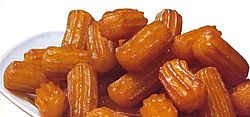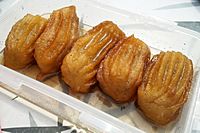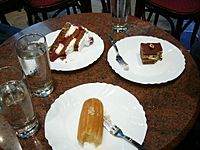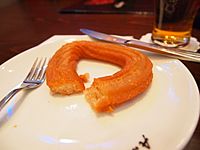Tulumba facts for kids

Tulumba
|
|
| Alternative names | balah ash-sham (Arabic: بلح الشام) |
|---|---|
| Type | Dessert |
| Place of origin | Ottoman Empire |
| Region or state | Countries of the former Ottoman Empire, Balkans, Middle East, South Caucasus |
| Main ingredients | Flour, butter, salt, water, syrup, vanilla extract |
Tulumba or Bamiyeh is a delicious, deep-fried dessert. You can find it in Turkey and many countries that were once part of the Ottoman Empire. It's made from a fried dough that is soaked in sweet syrup. It's a bit like jalebis or churros.
To make tulumba, cooks use a special pastry bag to squeeze out small pieces of dough. These pieces are about 3 centimeters long and have ridges, making them look unique. First, they are deep-fried until they turn a golden color. Then, while still hot, a sweet sugar syrup is poured over them. Tulumba is usually eaten cold.
What's in a Name?
The word Tulumba means 'pump' in Turkish. This name comes from the Italian word tromba. In some places, like Cyprus, it's called pomba or bombacık. In Armenia, people might call it pomp or tulumba.
This sweet treat is popular in many countries. You'll find it in Albania, Serbia, Bosnia and Herzegovina, Bulgaria, North Macedonia, Greece, Azerbaijan, and Turkey.
In Iran, it's known as bamiyeh. This name comes from the vegetable okra, which is also called bamiyeh in Persian. People call it this because the shape of the dessert looks a bit like okra.
In some Arab cuisines, especially in Egypt, it's called balaḥ ash-Shām. This means "Syrian dates" or "Damascene dates." In Iraq, it's called datli, which comes from a Turkish word meaning "sweet."
How Tulumba Is Made
Tulumba is made from a special dough that uses yogurt and starch. After the dough is mixed, it's fried until it's crispy and golden. Then, it gets a sweet bath in syrup.
This dessert is often enjoyed during Ramadan, especially at Iftar. Iftar is the meal where Muslims break their fast after sunset. Tulumba is sometimes served with jalebi. Jalebi is made in a similar way, but it has a web-like shape instead of ridges.
Images for kids
See also
 In Spanish: Tulumba para niños
In Spanish: Tulumba para niños






